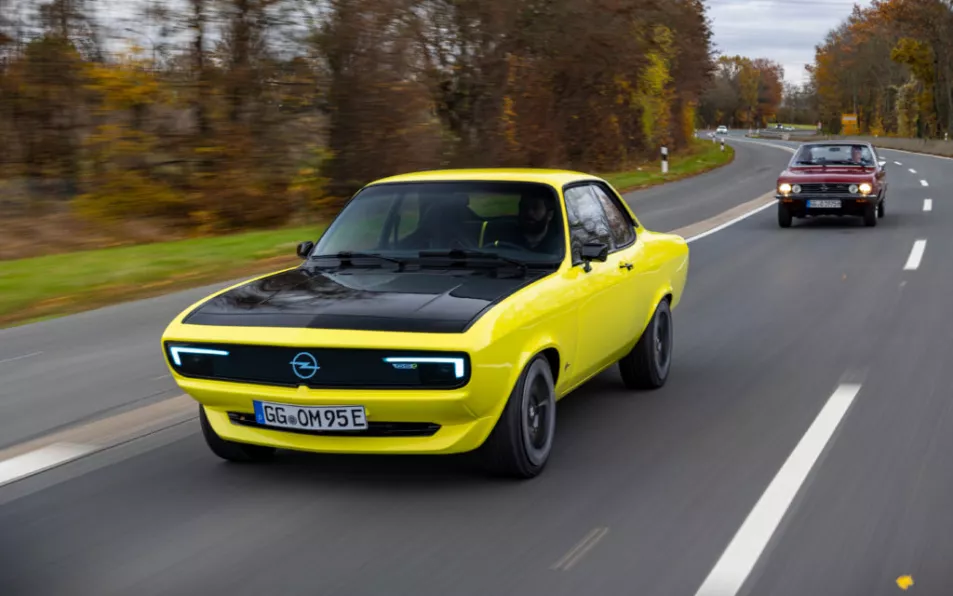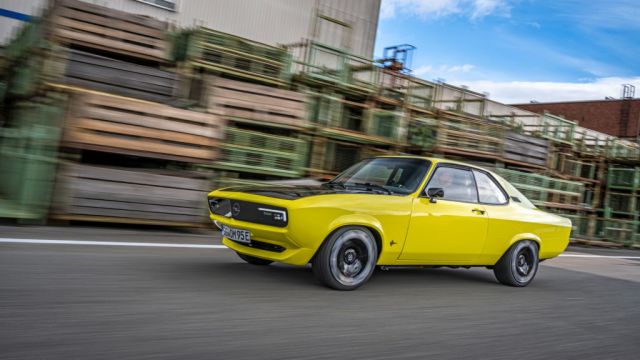Yellow is an oft-maligned colour. The colour of cowardice. The colour of late-night pre-exam study sessions, desperately highlighting useful sentences. The colour of weak lager.
Opel is hoping to change that, just a little. It’s hoping that the retina-searing hue of this Manta coupe will draw your mind away from Heineken and Stablio, and instead get you to view bright yellow as something to be cherished.
Certainly, any colour that’s applied to the shape of an early-seventies Opel Manta coupe is going to look good. Created, in 1970, as a rival for Ford’s all-conquering Capri, the Manta — for my money — is the better looking of the two, even if it never sold quite as well (although, in later years, it certainly made for a better rally car than the Capri…).
Just as Ford has gone back to the well of classic badges to help ease car buyers into the new age of electric motoring, so to has Opel. The Manta name is coming back — not on a coupe, alas, but on a new all-electric crossover, due on sale in 2025. That car will use an all-new electric platform, capable of ultra-fast charging, of 500km+ ranges, and 0-100km/h times in less than 4.0 seconds, but Opel want first to remind us that the Manta name has heritage. So it’s created an electric Manta.
The Manta name is coming back — not on a coupe, alas, but on a new all-electric crossover, due on sale in 2025
This bright yellow (with none-more-seventies black bonnet) Manta GSe Elektromod was originally made in 1974, painted orange, had a black vinyl roof, and had a mere 75hp powering its rear wheels through an automatic gearbox. It is a literal one lady owner car, bought by a woman from Wiesbaden, who donated it to Opel’s museum collection when she had finished with it. Until last year, it was happily languishing in a comfy retirement there.

Opel’s team apparently had to have a vote, at the last minute, as to whether they should ‘destroy’ the originality of the Manta to create this electric show car. The vote passed, and so out went the engine and gearbox, and fuel tank and exhaust, and much else besides. In came a custom-built 147hp electric motor, mounted in the engine bay. Into the boot went a 31kWh battery, and in between the two went a four-speed manual gearbox. Yes, manual — Opel’s engineering team decided that it was high time that an electric car had a bit more tactility to it, so here’s an EV you can change gear in.
Visor
Up front, the original four-headlight fascia was removed, and replaced with a version of Opel’s new ‘visor’ front end styling, as already seen on the Mokka crossover and on the incoming new Astra. If you’re thinking that the new visor looks curiously well-matched to the Manta’s styling, that’s because the whole idea of the visor was inspired by the look of the original Manta.
This one’s not just a grille and lights though — it’s actually a digital screen, framed by LED lights. On it can be displayed an Opel logo, as well as a series of digital messages and slogans. ‘I was born in the 1970s’ for example. Or ‘My German heart is now electric.’ Down the sides, there’s a badge in the shape of an actual manta ray, the aquatic creature from which the car takes its name. That badge is also a QR code, which when scanned takes you to the car’s own website.
Inside, the original dials and gauges are gone, replaced by twinned digital screens taken from the Mokka. The high-backed Recaro bucket seats are from an Opel Adam S hatchback that was found lying around. There’s no stereo — the original car had no radio fitted, so it was deemed fitting to leave one out — but there is a Bluetooth speaker so that you can listen to something as you drive.

You’ll need to, because of course the powertrain is silent. Well, not quite. Twist the ignition key and the electric system comes to life with a series of creaks and one particularly distinctive ‘awoooo-gah’ that’s actually the vacuum pump for the brakes. Getting the Manta GSe rolling is an odd exercise. Clutch down, you hook second in the manual gearbox (because with 255Nm of torque, there’s too much for first) but then you let the clutch out and… wait.
Gearshifting
Until the electric motor begins actually turning, nothing happens, so you can sit there as long as you like and then just press the accelerator to actually get going. It’s strange, but becomes easier with practice. The gearshift — as it is on all original Mantas — is long and loose-limbed, but shifting it around does make a difference, both to the power delivery and to the noise in the cabin. Get it cruising in fourth and, aside from a hurricane of wind noise around the 1970s-spec door seals, the Manta GSe is commendably refined.

It’s not quick exactly (0-100km/h takes between 8.0 and 9.0secs) but it cruises happily at normal speeds, and has plenty of poke in reserve. Opel reckons it can get around 200km on a fully-charged battery and with half-a-day’s driving under our belt, we can readily believe that figure.
The unassisted steering is a touch vague, but has lovely feel and feedback once you wind on a bit of lock, and the uprated suspension keeps the Manta feels agile and surprisingly taut as you scoot silently by. Only the brakes — also uprated, with rear drums replaced by discs, feel less than ideal, but there is some regenerative braking too, to help slow you down. Basically, it’s lovely — all the gorgeous styling of an original Manta, but with guilt-free emissions and modern tech. What’s not to like?
The future?
What does it mean for the 2025 Manta? Probably not much, beyond the nicely scripted badge on the bootlid.
Mind you, it’s certainly putting the Manta name back into people’s minds.
Opel had only planned on building this as a one-off, but the reaction has been so strong from both Opel dealers and the wider public, that there are now considerations for a limited production run, assuming that enough rust-free Manta shells can be found.
If I had the (doubtless hefty) price of one, I’d be first in the queue…







